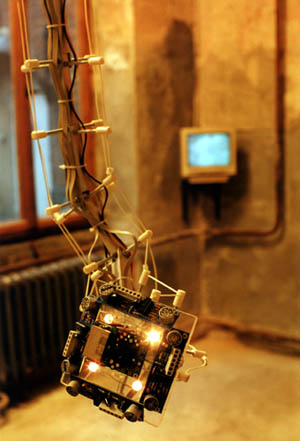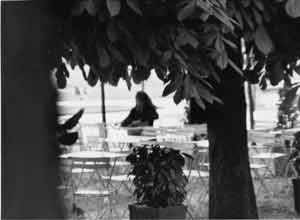CTRL SPACE EXHIBITION
Dutch-born artist Harco Haagsma in his own words examines the interplay between “looking and being looked at.” He employs video and sensor technologies in order to allow people to experience “looking at each other as a game”.

Biological System: Vilno, 1997 © Harco Haagsma
The installation Biological System: Vilno centers on a flexible mechanical arm that Haagsma has given the name of Vilno. Suspended from the ceiling, Vilno has on its lower end sensors and a camera. The scene of the action is marked out by four monitors located in the corners. Everyone who enters the room is perceived by the sensors. Vilno turns towards them and follows their movements. Though in purely practical terms it consists of undisguised technology, this ability lends Vilno the traits of a living creature. It seeks the closeness to visitors, seeks contact, seeks dialogue. At the same time, Vilno films the unsuspecting person immediately opposite. The image appears on all four monitors. The camera observes us and simultaneously has the task of moving us to responses, interactions, actions without which its functions would be useless or at least boring. Ultimately, the camera becomes a counterpart that cannot exist without our attention.
Moving away from direct interaction with cameras, one comes across French artist Sophie Calle. Throughout her career, she continuously has investigated into the topic of voyeurism brought to an extreme. Her early famous actions include following passers-by in the streets of Paris, France (one even going on to Venice, Italy) or to get a job as a housemaid in a hotel to investigate secretly into the guest’s private lives.

The Shadow, 1981 (Detail) (English Edition, 1985) Courtesy Sophie Calle and Paula Cooper Gallery, New York; VG Bild-Kunst Bonn, 2001, Photo: Tom Powell © Sophie Calle
The work in the exhibition, The Shadow, turns herself into the object of investigation: “In April 1981, at my request, my mother went to a detective agency. She hired them to follow me, to report on my daily activities, and to provide photographic evidence of my existence.” These laconic words introduce a strange double game: although the artist carefully plans her day, the deeper meaning of her undertakings remains a mystery to the detective. The layers of viewer and object fade away, as Sophie Calle takes the unaware detective to places that have a meaning only to her, like the Jardin de Luxembourg, where as a child she exchanged her first kisses, or the Louvre, where she tarries a while in front of a painting by Titian. Ultimately, the artist visualizes the failure of information transfer here: Despite all his professional routine, from his distanced perspective the detective gains no insight into the artist’s personality, not even when she deliberately organizes her day to include meaningful encounters. Only to the spectator in the later exhibiton, who is being offered help from Sophie Calle by her supplying personal information and comments, is able to let the riddle fall into place, linking the different layers of perception and observation, yet never able to gain a clear impression of these unknown persons.
Read more ...





